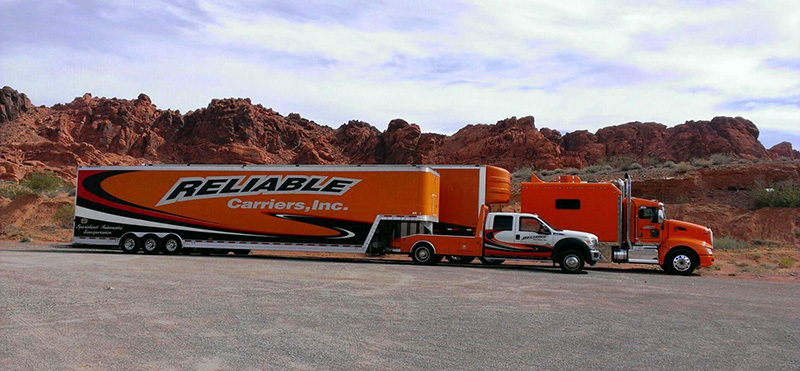 The US car market is forecast to contract slightly over the next two to three years, with sales set to fall from a high of 17.8m this year to around 16.3m in 2019, according to figures from industry analyst PwC. As OEMs cope with swelling inventory, the car carrier sector faces some difficult questions over excess capacity built up over a seven-year period of growth and investment. But a drop in new vehicle sales is likely to be more than compensated for by a rise in the movement of used vehicles, which account for the majority of business for many car carriers.
The US car market is forecast to contract slightly over the next two to three years, with sales set to fall from a high of 17.8m this year to around 16.3m in 2019, according to figures from industry analyst PwC. As OEMs cope with swelling inventory, the car carrier sector faces some difficult questions over excess capacity built up over a seven-year period of growth and investment. But a drop in new vehicle sales is likely to be more than compensated for by a rise in the movement of used vehicles, which account for the majority of business for many car carriers.
What is more, although new vehicle sales are forecast to drop by more than a million, some OEMs expect to grow their business, while the increasing number of different models they produce, including larger passenger trucks and hybrid or electric vehicles, will bring other challenges for capacity management.
Car carriers are used to adversity. A long period of growth with exacting demands by the OEMs, while welcome, has brought some casualties along the way. Nevertheless, investment in equipment and technology for visibility and planning continues to be made across the board.
Credit where it’s dueVolkswagen Group has been expanding sales in the US and is set to grow further following the start of Audi Q5 and Tiguan SUV production in Mexico last year, and the recent launch of the Atlas SUV from its plant in Chattanooga, Tennessee. While the carmaker importa a large share of vehicles, Atlas output is expected to increase local output substantially (VW built more than 93,000 Passats sedans last year).
VW now has more than 20 contract carriers in the US and is adding to that number in the second half of this year, most notably with the addition of Colarado-based Fleet Car Carriers to support activity out of a terminal being developed on the US west coast, which opens in the fourth quarter of this year.
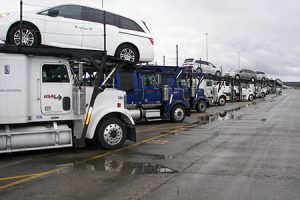
The carmaker has not said much about the terminal yet but its vehicle carriers work out of the four port locations the carmaker has in the US for ocean imports – at Brunswick (Georgia), Jacksonville (Florida), Davisville (Rhode Island) and Wilmington (Delaware) – as well as supporting car movements out of its factory in Tennessee and 14 railheads, including the ports of Houston, Texas and San Diego, California, which receive vehicles from Mexico.
“We have been very pleased as a whole,” says Mark Boucher, Volkswagen Group of America’s director of vehicle logistics. “There are ups and downs and some that do better than others, but we watch metrics very carefully and work with those guys when we do have concerns. On rare occasions we replace carriers, but that does not happen very often.”
According to Chuck Kendig, assistant vice-president of sales and production planning and logistics at American Honda, when it comes to working with outbound road transport providers, it is a case of rolling with the blows. “Nothing ever runs as perfectly as strategised and scripted on a planning document, and we continually develop countermeasures on an operational basis to meet market demands,” he says.
Nevertheless, he notes the commitment that carriers have shown. “Our carriers have been with us during the growth years and we sincerely appreciate their support,” he says.
Honda is now working with 15 car hauliers across the network, which was built up during sales expansion in recent years but levelled out about six years ago.
Boucher says one of the things that is working well for Volkswagen is the modest size of its business in the US, compared to other parts of the world. “We are not a big percentage of the market in the US and this allows us some flexibility that some of the other OEMs are not able to enjoy,” he says. “We take advantage of that where we can.”
Volkswagen Group of America sales in the first six months of 2017 totalled more than 293,000, an increase of 7.2% on the same period in 2016, according to the Automotive News Data Center. Last year, it sold more than 591,000 units.
“We have come, over the years, to value the relationships we have with a handful of carriers,” says Boucher. “As we have grown and expanded we have taken on new ones and are able to figure out who is more reliable than others… but overall we have been pleased and the aim is to grow and expand some more.”
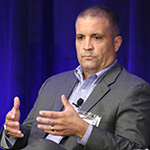 "As we have grown and expanded we have taken on new [carriers] and are able to figure out who is more reliable than others… but overall we have been pleased and the aim is to grow and expand some more." - Mark Boucher, Volkswagen Group of America
"As we have grown and expanded we have taken on new [carriers] and are able to figure out who is more reliable than others… but overall we have been pleased and the aim is to grow and expand some more." - Mark Boucher, Volkswagen Group of America
On the goal of expansion, Honda’s Kendig concurs: “As we look to the future, we will do what is necessary to thrive and succeed, regardless of market conditions.”
Those market conditions have no effect on the expectations Honda places on its carriers, however. “We expect damage-free delivery [with] on-time performance based upon agreed transit standards and dwell time,” he says. Furthermore, Honda expects contract terms to remain relatively consistent in length with the previous ten years. It is this consistency that helped the company navigate the last economic downturn and its subsequent recovery, according to Kendig.
“We look for carriers that are adaptable to changing business conditions and capable of maintaining consistent performance through leaner as well as robust periods, similar to our internal approach as a manufacturer,” he explains.
Continued investmentDespite leaner demand for new car movements, US carriers are likely to continue investing in new transporters. A survey conducted by Automotive Logistics in collaboration with the Auto Hauliers Association of America (AHAA) and 12 of its 70-plus members suggests such investment has ranged quite widely in the last three years, however.
Reliable Carriers, for example, has invested around $25m in 60 units over that period and is planning to invest a further $20m in 50 more over the next three years. General manager Justin Newell says that 30% of the trucks represent incremental capacity with 70% replacements.
“We will have minimal capacity once we appropriately focus on the customers and segments we wish to be in,” says Newell. “We have recently been awarded some very prestigious projects and will grow our business about 10% this year.”
Reliable Carriers expects to move around 140,000 vehicles this year, up from 125,000 in 2016.
 United Road’s president Mark Anderson points out that carriers’ speed and flexibility is often affected by a disparity between OEM forecasts and the reality of how many vehicles are made available and when they are provided
United Road’s president Mark Anderson points out that carriers’ speed and flexibility is often affected by a disparity between OEM forecasts and the reality of how many vehicles are made available and when they are providedShank Brothers Auto Transport, by contrast, has invested $650,000 in additional units over the last three years but is dropping that by around a third over the next three. Tom Shank, owner of the company, says he does not foresee any problems with excess capacity going forward.
Another carrier surveyed, who prefers not to be named, has invested $1.2m in four units in the last three years but is wary about upcoming investments due to the economic forecast.
One issue that clearly affects such investment decisions is the accuracy of forecasting from OEMs – a point raised earlier this year at the FVL North America conference in California. There, Mark Anderson, president and chief operating officer of United Road – which carries more than 3m vehicles a year in the US and Canada – said carriers were measured on speed and flexibility because the business was all about dwell time. But frequently, he added, carriers did not receive what they were told they were going to and often they received vehicles outside the intended time slot.
An eye on inventoryWhile there is sufficient capacity at the moment, the sales downturn brings risks to firms at either end of the scale, from the smaller carriers who may not be as financially secure as some other firms to the potentially unsustainable giants in the sector. That could be a problem if inventories continue to rise.
“We have to watch those trends very carefully and make sure we don’t lose any of our contracts,” says Boucher. “It is no secret: everyone is seeing the inventory levels at the ports rising in the US, which is a little scary.”
The US market has now exceeded 4m units of unsold inventory, a level not seen since 2005 when the country was heading for recession, with supply far outweighing demand. Inventory continues to rise in the US despite the dip in sales and there is now an average 70-day supply of vehicles, though some brands have substantially higher levels.
Meanwhile, company acquisitions are now less popular, according to the medium-size carriers, who are mostly focused on organic growth.
 "One of our carriers placed a substantial order for 80ft equipment and plans to use it to address spacing [and damage] issues brought about by having to load larger product." - Chuck Kendig, American Honda
"One of our carriers placed a substantial order for 80ft equipment and plans to use it to address spacing [and damage] issues brought about by having to load larger product." - Chuck Kendig, American Honda
When the US market was in full stride in its recovery, there were a number of mergers and acquisitions that changed the face of the market. United Road’s buyout of Waggoner Auto and Jack Cooper’s purchase of Allied, both in late 2013, were just two of the bigger ones (though to what extent the latter has left itself financially exposed remains to be seen; Jack Cooper, rumoured to be facing financial difficulty, declined to take part in this article).
“United Road and Waggoners, at the time of that acquisition, were probably two of our top carriers, so when that happened it was met with some trepidation,” admits Boucher. “We do like diversification in trucking and they say ‘don’t put all your eggs in one basket’. That said, I don’t think we’ve missed a beat; it has worked just fine and in a lot of ways it has become easier just because you are dealing with and paying one company.”
United Road has itself since been bought by global investment firm, Carlyle Group (see box below).
In the first week of September, it was announced that private equity and investment firm, Carlyle Group, had bought United Road Services, currently the second largest vehicle carrier in the US, for an undisclosed sum.
Carlyle said it bought United Road via its Equity Opportunity Fund II, a $2.4 billion fund that invests in middle-market companies in the US that require equity capital of $20m to $200m per transaction.
United Road moved more than 3m vehicles last year and is on track to surpass 3.5m in 2017, up from 1.5m in 2012.
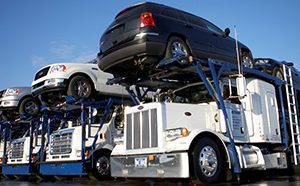 According to Kathleen McCann, chairman and chief executive of United Road, the company provides services for every foreign and domestic OEM selling new and remarketed vehicles in the US and many in Canada. However, she still sees plenty of room to grow in a market that is fragmented.
According to Kathleen McCann, chairman and chief executive of United Road, the company provides services for every foreign and domestic OEM selling new and remarketed vehicles in the US and many in Canada. However, she still sees plenty of room to grow in a market that is fragmented.
Carlyle bought United Road from Charlesbank Capital Partners and according to McCann it had been following United Road’s fortunes since it was sold to Charlesbank by rival investment firm Gores Group back in 2012. McCann said Charlesbank was a “terrific partner” for United when it took over, citing strong financial support for acquisitions, which included Waggoners.
Following the announcement of the Carlyle takeover, she said the company was looking forward to the new prospects it had under Carlyle, with a view on organic growth and financial stability.
In terms of the impact on United Road, McCann said she did not foresee any material changes, with focus remaining on increasing market share and increasing use of technology.
With regards to the slowdown in the US car market, McCann said the used vehicle sector would compensate.
“Due to the diversification of our business, we anticipate that the countercyclical nature of the remarketed vehicle segment will keep our people plenty busy servicing our customers,” she said. “We have also seen some nice new contract wins on the new vehicle side – so plan to grow through what appears to be a modest down-cycle in the immediate future. Selling 16m new vehicles per year is still very healthy on a comparative basis. We’re very bullish on our business and our customers overall.”
The greater visibility provided by such systems – and ePod in particular – is a priority for OEMs like Honda. “Electronic proof of delivery efforts are almost complete with a majority of the truck carriers using this form of delivery confirmation,” says Chuck Kendig. “We continue to work with the truck carriers and our dealer network to embrace these changes and expand the capability of this technology for other delivery improvements.”
Honda has also maintained a robust yard management system at each of its own distribution centres, according to Kendig. “Over the last several years, we have been developing our own internal vehicle tracking system,” he says. “We have designed both systems to benefit not only Honda and our dealers, but also our logistics partners, and we reflect their input in our constant improvement of both systems.”
At Volkswagen Group, Boucher says carriers need to be aligned with specialist tracking provider ICL Systems for data and metrics reporting. ICL Systems handles data exchange management, asset tracking and electronic invoice auditing for the carmaker, among other things.
“We have a long-standing relationship with ICL and what they have with the carriers is beneficial,” says Boucher.
Better technology is also being built into facilities at Reliable Carriers, says Newell.
“We have completely redesigned our network infrastructure and moved to high-speed fibre-optic in all of our facilities,” he confirms.
High demand for trucks and larger SUV-type passenger vehicles in the US as oil prices have dropped is another factor influencing capacity. Boucher cites the change in production at the Chattanooga facility as an example.
“For the first five and a half years, all we shipped was the Passat because it was the only model we built there,” he says. “We were able to get nine of those on a truck. With the new Atlas model, it is seven. By sheer numbers you have less capacity and it is the same with the Tiguans and other SUVs – they affect the load factor.”
Boucher says there have not yet been any systemic truck shortage issues for the company, but there are sometimes issues in terms of speed to market for new products, for example in the company’s recent flurry of SUV launches in North America.
“They are critical vehicles and have to get out quickly,” he says. “[For launches like this] you don’t use the rail as often, you use more truck to speed them to market. That is great, but it does strain the resources of the carrier.”
The consequence of using truck assets for longer-distance deliveries to ensure timely arrival of a new product is that turnaround times are hit, he admits. It also means using a lot of back-up transport providers. However, he says the carriers VW uses in the US have been “outstanding” in getting the cars delivered without damage.
“We go down the list and we find our guys and they come in and work with us,” he says. “We are in the middle of the Atlas right now; we have already done the Tiguan and Q5, and it has worked really well. There are always challenges but it has worked really well.”
For Honda, which has tilted slightly towards greater use of truck transport this year for passenger vehicle deliveries, the issue of finding capacity is more about changes in manufacturing location. As an example, Kendig points to the shift in production from Ohio to Indiana of the Honda CR-V.
“Previously, Indiana had been exclusive to passenger car production,” he says. “This obviously can have an impact on load factor and quite possibly capacity. However, over the course of time that can all revert, grow or stabilise.”
The response from carriers to increasing vehicle size is mixed. [mpu_ad]For some, it has hurt business because the vehicles take up more space, weigh more and present more damage issues, all of which dealers do not want to take into account when setting prices, according to one survey respondent.
When the US Congress approved the Fast Act in December 2015, the car carrier sector welcomed the increase in the loaded length of a transporter by 5ft to 80ft (24.4 metres) but the weight restriction for US highways remained in place, which prevented most carriers from being able to increase load factors. At the same time, damage concerns mean carriers tend to space vehicles out more on a rig, all of which affects capacity.
[related_topics align="right" border="yes"]For some, the return to bigger vehicles has forced major design changes in equipment, while for others, the flexibility of existing equipment is sufficient to deal with the situation.
“We want all of our equipment to have as much flexibility and adaptability as possible to handle the needs of our customers and their future and current models,” says Justin Newell.
Reliable Carriers suggests the increase in maximum loaded length has increased capacity, reduced damage and led to opportunities for more varied configuration in loading trailers. Brent Larsen, chief executive at Auto Transport Group, confirms that his company has seen increased vehicle capacity with the addition of specialised 80-ft carriers.
At Honda, Chuck Kendig says it has seen a slight decrease and stabilisation in the damage rate since the new regulations on length, adding that load factor efficiency has remained consistent over the year, though he says there have been some challenges related to the shift in production model mix.
“One of our carriers placed a substantial order for 80ft equipment and plans to use it to address spacing issues brought about by having to load larger product,” he says. “They are hopeful this will assist their efforts to manage the potential for damage.”
 "Due to the diversification of our business, we anticipate that the countercyclical nature of the remarketed vehicle segment will keep our people plenty busy servicing our customers." - Kathleen McCann, United Road
"Due to the diversification of our business, we anticipate that the countercyclical nature of the remarketed vehicle segment will keep our people plenty busy servicing our customers." - Kathleen McCann, United Road
The potential growth in electric and autonomous vehicles also heralds new challenges for car carriers in terms of weight and handling.
Weight is a primary concern for many, as electric vehicles are generally 15-20% heavier than internal combustion engine cars, because of the weight of lithium-ion batteries. Reliable Carriers says there are also potential electrical issues when cars are being loaded.
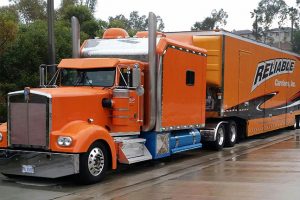 There are few transporter manufacturers supplying the car carrier sector in the US. In fact, the market is dominated by just one – Cottrell – though there are signs that competition may be returning with Delavan reporting reinvestment in its manufacturing facilities. Other companies, such as Boydstun, are also releasing new equipment.
There are few transporter manufacturers supplying the car carrier sector in the US. In fact, the market is dominated by just one – Cottrell – though there are signs that competition may be returning with Delavan reporting reinvestment in its manufacturing facilities. Other companies, such as Boydstun, are also releasing new equipment.
While some car carriers have experienced a reduction in order-to-delivery times, others report waiting times for equipment of anything up to nine months. “With the forecast in the automotive industry, I only see that getting worse,” says one survey respondent. “The truck dealers are not going to want to have stale inventory that depreciates while its sits.”
Reliable Carriers’ Justin Newell confirms that the supply of equipment is still rather slow but says some carriers have locked up longer agreements with manufacturers and are starting to do some of the additional build-out themselves.
Mark Boucher of Volkswagen Group points out that competition is good for driving prices down and suggests having just one or two equipment makers is not good. “I think more competition would be good, because it would ultimately trickle down to us if the carrier got better pricing on the equipment they buy,” he comments.
Honda’s Chuck Kendig agrees: “I am sure that most car haulers would tell you they would like to see more options and competition, as it would likely help with pricing.”
Delavan – which is part of the France-based Lohr Group of companies – says it is making efforts to improve the supply of equipment. President and chief executive Philippe Fortmann says the company has recently reinvested in upgrading its Newnan plant in Georgia and recruited new staff in all departments, including quality, production and engineering. It has also strengthened its supplier and contract network.
According to Fortmann, Delavan has re-engineered its 80ft range of equipment – the Evo series – and production cycles have been cut to achieve higher capacity. Delavan’s ambition, he adds, remains to upgrade existing North American car haulier fleets to new legal and quality norms and equip them so they can adjust to higher demand at any time.
“For the next three years at least, Delavan will be in growth and market share mode,” says Fortmann.
“When we are loading them, they are going with seven or eight other [standard] cars,” says Boucher. “It is not impacting it enough to make a difference.” He admits, however, that spots could be lost in the future if the industry gets into higher volumes of such vehicles.
As far as handling goes, Boucher says there are no real issues as long as the vehicle is operational. “Where you run into issues is when you have a non-runner,” he says. “But this gets more to the port level than the truck level.”
From a labour point of view, there has not been an issue at carriers in terms of moving electric vehicles, adds Boucher.
“The guys are willing to handle them; I have not had a phone call from a truck carrier saying ‘it is on my truck, it won’t start and I don’t know what to do with it’.”
Honda says it expects providers to have the infrastructure in place to support the specific needs of electric and hybrid vehicles, though Kendig says it’s something the OEM will help with. “We will support them in building this infrastructure as it becomes necessary,” he confirms. “The market will determine the distribution patterns and we will work with our providers to make this shift if necessary.”
In terms of finding adequate capacity for a greater vehicle mix, Kendig says carriers must be flexible but admits that it is the OEMs’ responsibility to provide a clear picture on where that capacity is needed.
“Given enough time to react to any capacity shifts, our carriers always respond positively and alleviate any pressure points,” he comments.
Business as usual… so farAs it moves forward under the new political administration in the US, the car carrier sector is monitoring legislation on everything from fuel and trade to infrastructure investment.
In terms of infrastructure, Brett Larsen at Auto Transport Group says the company is hoping for more comprehensive plans to address congestion, commercial vehicle parking and much needed improvements to the interstate system.
The new US administration has said it could increase fuel tax to fund infrastructure improvements, something Donald Trump suggested the trucking industry would agree to because US roads were in such a bad condition.
The administration has promised $1 trillion in infrastructure investment over 10 years for roads, bridges, airports and transit systems, following years of underinvestment. But many questions over funding remain.
On the question of fuel taxes, Justin Newell says there has already been a noticeable increase, at least at state levels, which is driving up the cost of doing business. However, he notes, the Trump administration is pro-business and growth, which hopefully means regulations will be eased.
Boucher at VW agrees, though he admits the company is watching developments closely. “I know that the president is a businessman probably above all else and I think he’ll make decisions that are in the best interest of business,” he says.
Securing future contractsWhatever the government plan and fluctuating market, the things OEMs are looking for in their carriers remain largely the same. Honda lists these as customer focus, reliability and responsiveness to the dealer, the field operations staff and national management. It is also about commitment to the contract standards and ease of doing business.
However, environmental impact is now a stronger factor and Kendig says his company is striving to reduce CO2 emissions in everything it does, including finished vehicle deliveries. “We increasingly look for partners with the latest technology, the most efficient and clean engines and a plan to dramatically reduce emissions in their operations,” he comments.
Mark Boucher wants to make sure that carriers can support Volkswagen’s growth and changes of model mix. “The overall number is supposed to go down by 1m cars [per year] and yet every OEM will tell you that we are growing, so I don’t know where it is going to come from, that attrition, but we do expect to grow at VW,” says Boucher. “So when we look at our carrier agreements, we know our footprint is going to change as we grow and we want to take on more contracts.”
Kendig says Honda also has a growing interest in intermodal transport. “Collaboration between the railroads and truckers has been a positive step and we look to continue to support and assist [that],” he says.
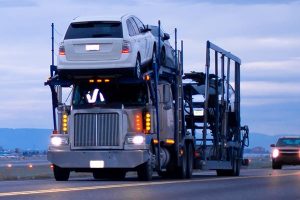 One particular issue facing the US carrier sector is the recruitment of drivers – a perennial problem for the industry for some years as the average age of the workforce has crept up, and one recognised in our survey by both carriers and OEMs as one of the main challenges in maintaining sufficient transport capacity.
One particular issue facing the US carrier sector is the recruitment of drivers – a perennial problem for the industry for some years as the average age of the workforce has crept up, and one recognised in our survey by both carriers and OEMs as one of the main challenges in maintaining sufficient transport capacity.
Better pay and more home time are generally seen as the best two ways of attracting and retaining drivers. Justin Newell says the recruitment of qualified drivers continues to be a problem but that Reliable Carriers is doing what it can to retain its pool of talent. “We have one of the lowest turnover percentages in the industry,” says Newell. “We run some of the best equipment, have a good company culture, take care of our drivers, compensate them well for their efforts and make sure they stay busy.”
Younger people looking for work need to be made aware of the wage benefits of the sector, says Newell, but he recognises that they are not keen to be kept away from home for longer than necessary. “Trying to get your drivers home on time is important – but not always easily done,” he admits.
Brent Larsen at Auto Transport Group believes that solving the driver shortage will also involve investment but that it is a complex issue. “It will require more than increased wages and benefit costs to bring new drivers into the business,” he says.
Additionally though, our survey reveals a perception that onerous driver regulations are also putting potential drivers off.
“This is the only industry that is so regulated, people are afraid to work in it,” says one survey respondent, who admits that his company has changed pay structures, increased benefits, paid holiday and anniversary bonuses, and increased home time in an effort to attract and retain staff.
The same respondent suggests, however, that drivers themselves, rather than their employers, are the ones who should be fined when violating hours-of-service regulations. These stipulate that drivers who reach 70 hours of driving in a week can only resume work after resting for 34 consecutive hours, including at least two nights between the hours of 01.00 and 05.00.
“We can only do so much to drive desired behaviour,” says this respondent. “If we use progressive ‘meaningful action’, the drivers just quit and go elsewhere. If they were accountable, they would pay more attention to regulations.”
On this note, the FMCSA has established a deadline for eliminating paper logs in December this year but there has been some resistance by driver unions to ELD and electronic hours of service compliance, and some US carriers are conscious that they could lose drivers as a consequence of the ruling.
Newell says Reliance Carriers will be working in close compliance with the ELD when it goes into effect but adds: “We will definitely lose some drivers over this initiative, without a doubt”.
Honda’s Chuck Kendig also recognises the problem of driver recruitment. “The challenge is finding the right person that has the skills to load a car-haul rig and the ability to work in all kinds of weather,” he says. “The driver is also the representative for the truck carrier as well as Honda at the dealership.”
Topics
- american honda
- Audi
- Auto Transport Group
- Battery Supply Chain
- Carlyle Group
- Digitalisation
- features
- Finished Vehicle Logistics
- Fleet Car Carriers
- Inventory management
- Jack Cooper
- Lohr Group
- North America
- Policy and regulation
- Reliable Carriers
- Road
- Shank Brothers
- Supply Chain Planning
- United Road
- United States Of America
- UPS
- Volkswagen Group

























![Global[1]](https://d3n5uof8vony13.cloudfront.net/Pictures/web/a/d/s/global1_726550.svgz)









